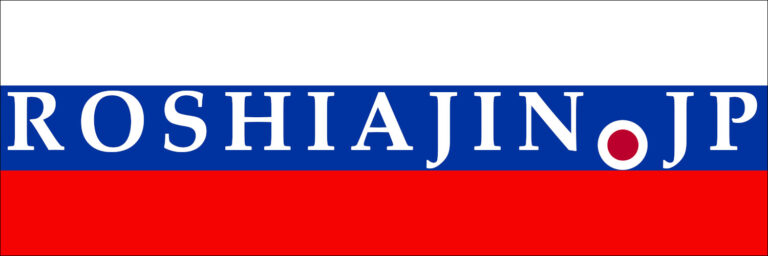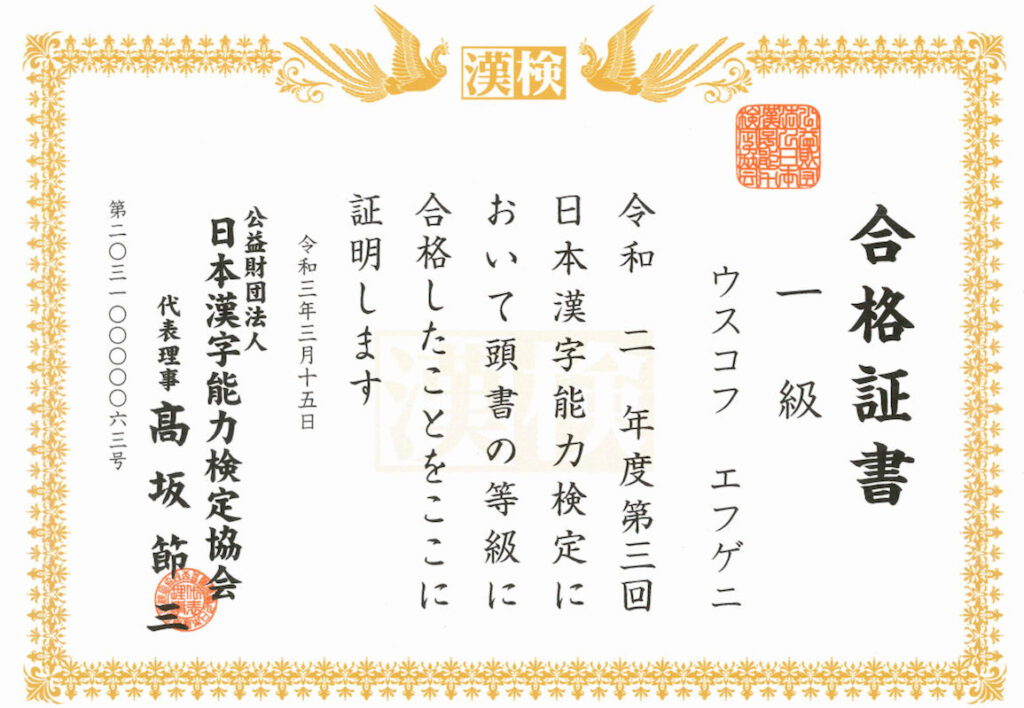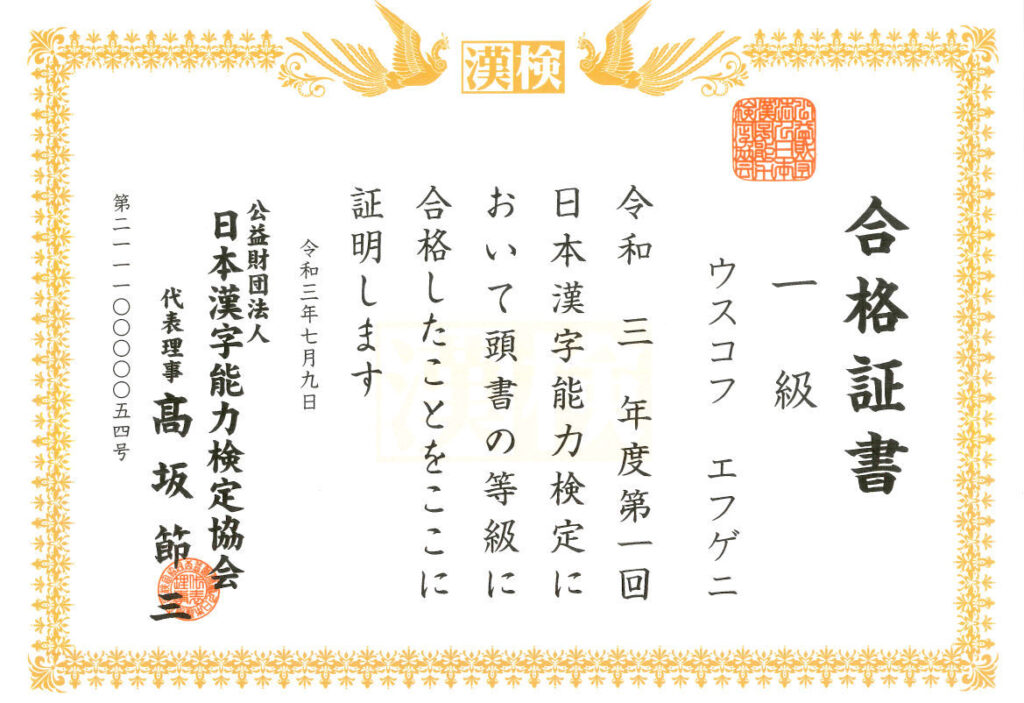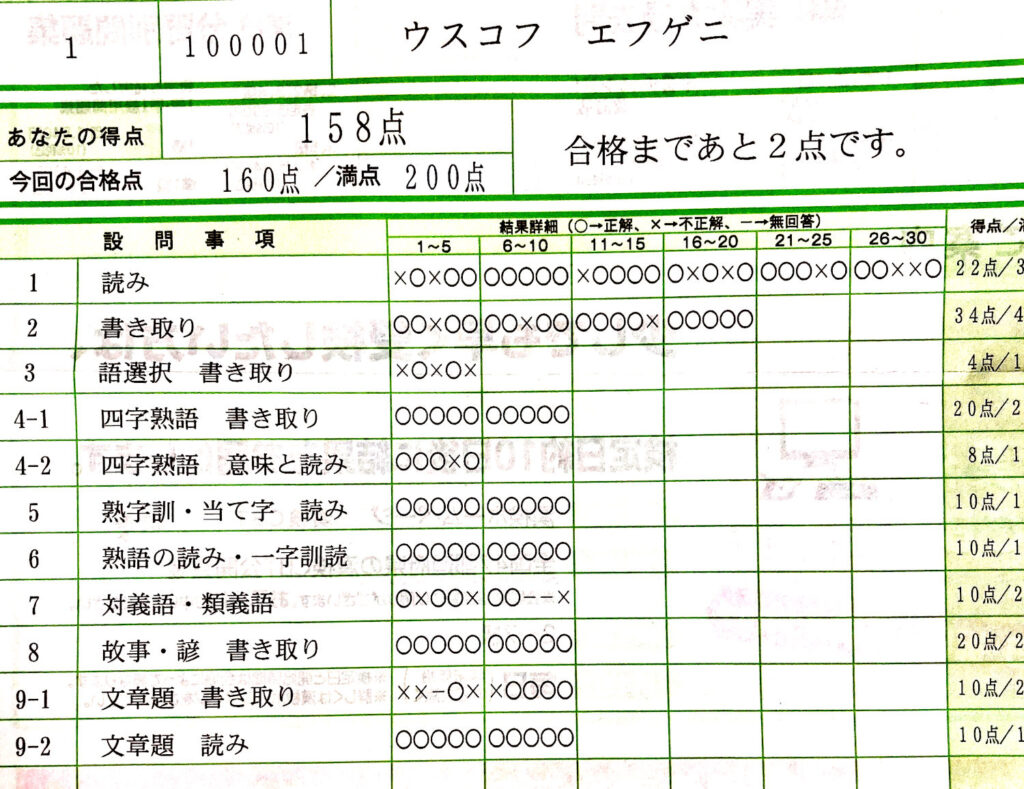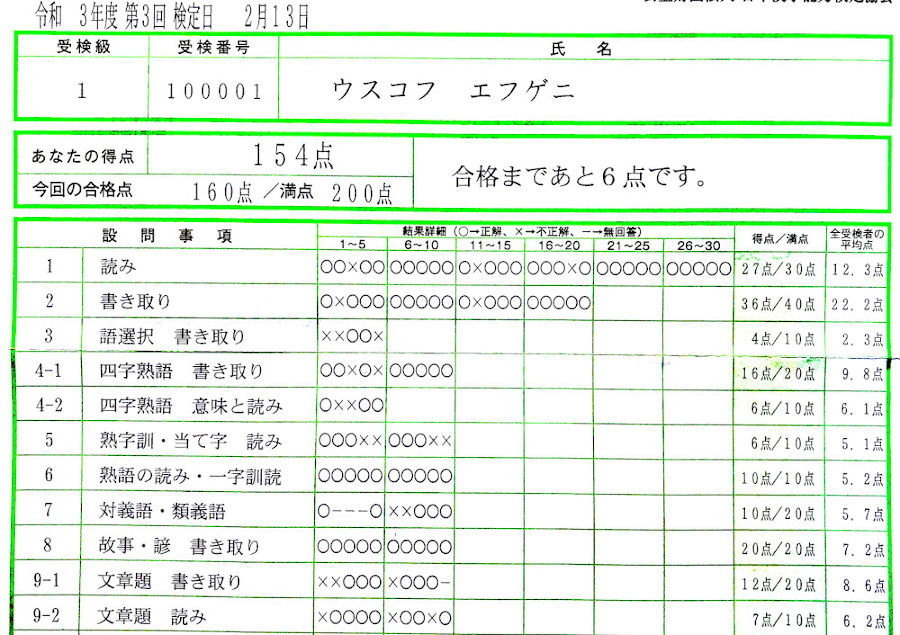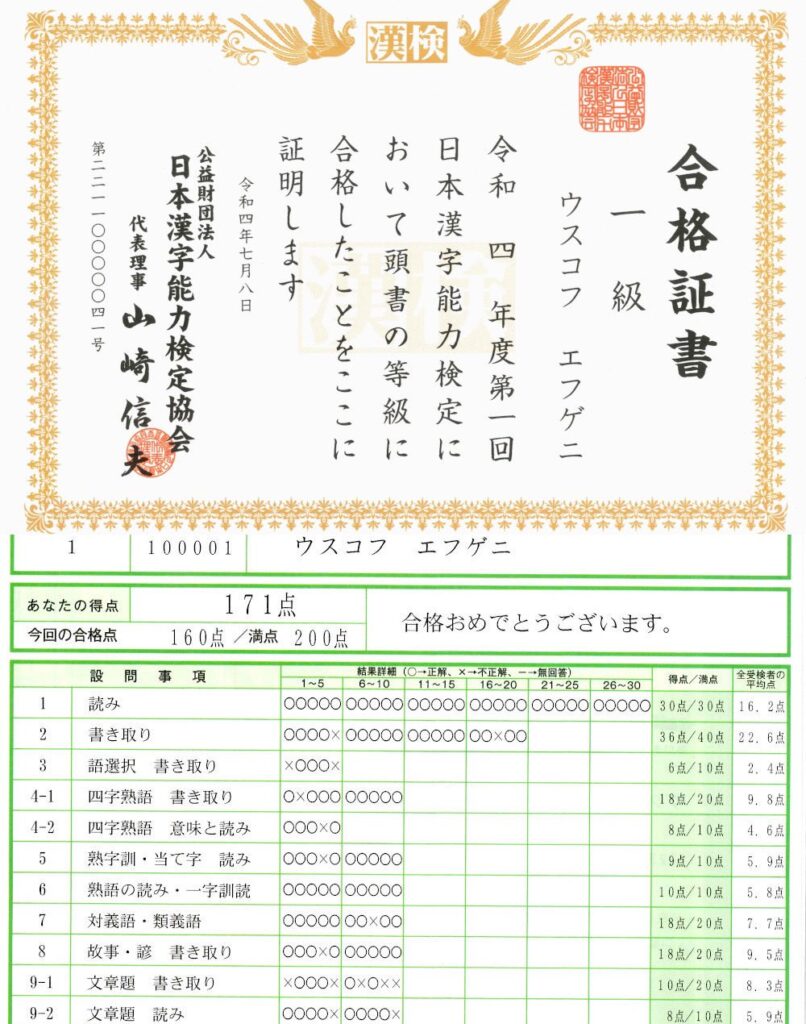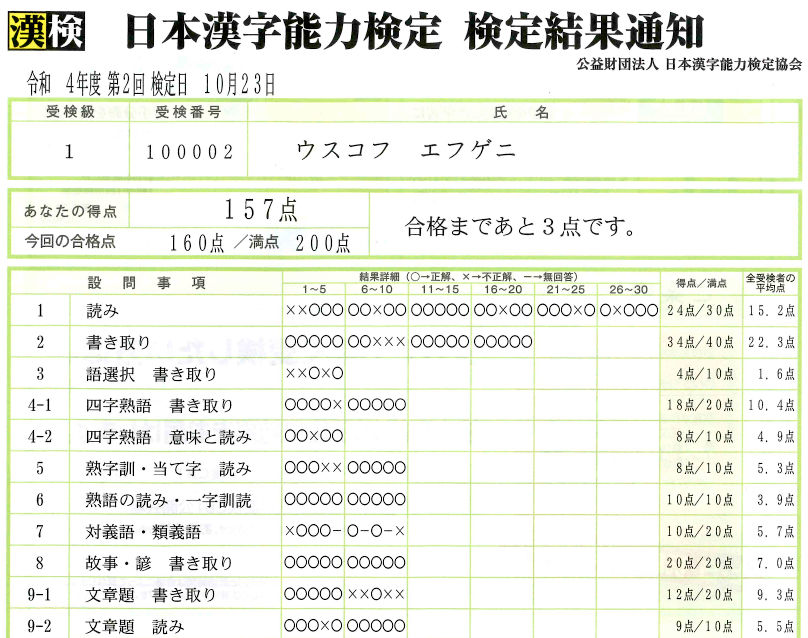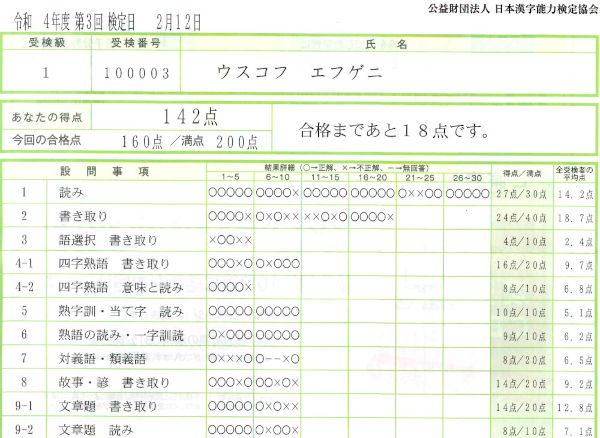What is Kanji Kentei level 1 (Kanken level 1) test
Administered since 1992, Kanji Kentei, also known by its official name as the “Japan Kanji Aptitude Test“, organized by the “Japan Kanji Aptitude Testing Foundation“, is an examination to test one’s writing skills and knowledge of kanji (漢字 or “Chinese characters”) as well as Japanese vocabulary based on them.
The test itself is subdivided into 12 levels or grades: nominally, the number is 10, but when you include levels pre-2 and pre-1 the total number is 12, each of them having its own scope, with each ascendant level by default explicitly or implicitly encompassing the content of all preceding lower levels.
Here we will specifically talk about the highest level of the Kanji Kentei test — Kanken level 1, which alongside Nihongo Kentei level 1, is considered to be one the highest accreditations Japanese language learners (both native and non-native alike) are able to acquire.
Although nominally the test measures one’s knowledge of “kanji”, the content is by far not limited merely to information on individual characters’ readings and meanings, with the test’s purport rather being to gauge one’s ability to use both characters themselves and kanji-based vocabulary to understand texts that are written using them.
Thus, in a broad sense, Kanken — especially its first level – can be described as a test of one’s Japanese language proficiency in terms of the ability to comprehend textual material written using kanji characters as well as to write the characters and words by hand.
With regards to handwriting it should be noted that although Kanken is not a calligraphy test, it requires following certain specific rules pertaining to the correct way of writing kanji characters (stroke order, character shape, etc.) in 楷書 (kaisho) font. This also applies to hiragana which in most cases is used for answering reading questions — wrong or otherwise untidy shape of hiragana symbols may cause an answer to be marked as incorrect.
While in terms of which particular kanji characters examinees are supposed to be familiar with, the Kanken level 1 test’s content is limited to those kanji that have their dedicated entries in the “Kanken Kanji Jiten” dictionary (with the total number being around 6300) the vocabulary (i.e. readings of individual characters, compound words made up from characters, etc.) that can be used for questions is not restricted to its content.
For “yojijukugo“, or 4-character compound phrases (idioms), the canonical source, as recommended by the test’s organizers, is the “Kanken Yojijukugo Jiten” — but while indeed the majority of yojijukugo used in each individual test can be found in that dictionary, on certain occasions yojijukugo compounds which are not included in it may be used for questions as well.
For successful passing, an examinee needs to score at least 160 points out of total 200, or have an overall 80% accuracy (unlike Nihongo Kentei level 1, there is no minimal passing threshold for each individual section).
The Kanken level 1 test consists of 9 sections. Below we will give a brief description of each of them (as of December 2024).
Structure and content of the Kanji Kentei (Kanken) level 1 test (漢検1級)
Section 1 consists of 30 questions each carrying 1 point. The section is subdivided into two parts: first 20 questions for on-readings, and questions 21-30 are for kun-readings.
Some questions on on– and kun-readings (those which have different readings with the same okurigana) may test one’s ability to differentiate between different semantic elements of the same character:
e.g. 矜恤 is キョウジュツ, but 棘矜 is キョクキン, or 諄 can be either くど(い) or あつ(い) depending on the context.
The vocabulary used in this section, is usually either solely based on characters allocated for level 1 (sometimes a combination of level 1 and pre-1 kanji) — which by itself cannot be correctly answered without specifically knowing each character’s reading — or made up from kanji allocated for lower levels, but selected in a way so as to preclude correct answers by analogy through standard readings (i.e. compound words with non-conventional readings like 徴羽).
The section may also include the so called “hyougai-yomi” or non-standard readings of 常用漢字 (i.e. 北く = そむく).
Section II. Writing
Section 2 consists of 20 questions with each carrying 2 points. The section can be subdivided into 3 parts:
1) questions 1~16 asking to write down in kanji the readings given in hiragana;
2) writing down in kanji groups of homonyms (2-5 questions);
3) 2 questions for “kokuji” or characters created in Japan using parts of existing Chinese characters
(note: before 2016, the number of kokuji questions was 5 which to a certain degree made passing the test easier as the total number of such characters is limited, and people who seriously prepare for the test usually answer all these questions correctly)
Questions for this section may include a wide range of vocabulary starting from “hyougai-yomi” (like 逸れる=はぐれる or 憤る=むずかる), Buddhism-related words, specialized lexicon from various spheres (from astrology to medicine, etc.), interjections which are usually written in hiragana, etc.
Section III. Word selection / writing
In Section 3 examinees need to choose which readings given separately in hiragana correspond to which definitions given in questions, and write the correct readings in kanji. The number of available readings is bigger than the number of definitions (i.e. some readings are not applicable to any of the definitions).
While having a relatively limited weight (5 questions each carrying 2 points), alongside Section 7, this Section is considered to be one of the most difficult parts of the test. Some readings that need to be written down in kanji are three-character compounds like 担板漢, many of which are quite rare, and thus require an extensive knowledge of Japanese vocabulary to be answered correctly.
Section IV. Yojijukugo (4-character idioms)
In the first part of this Section ten yojijukugo idioms are given with either the upper (first two characters) or the lower part (second two characters) written in hiragana, and an examinee needs to choose a reading that would fit each idiom from the readings given separately in hiragana, and write them in kanji (the number of hiragana readings is equal to the number of questions).
The second part consists of 5 questions testing one’s understanding of idioms’ meanings: it is necessary to choose the idiom that would correspond to the meaning described in each question, and write that idiom’s underlined part in hiragana.
As a general note it can be said that as the Section carries a hefty total of 30 points, and the questions are rather straightforward (compared to more heuristic-oriented Sections of the test where one needs to do a lot of guess-work), successful passing of the Kanji Kentei level 1 test would usually require earning a perfect or nearly perfect score here.
Section V. Jukujikun (special reading words)
Section 5 has 10 questions with 1 point for each correct answer requiring to write down special readings of kanji-compounds which are not based on the constituent characters’ standard on– or kun-readings (e.g. 紫陽花 = あじさい).
Although the relative weight of this Section is low, and the number of jukujikun-readings that can be used for its questions is counted in many thousands (each of which needs to be memorized) it may be tempting not to allocate that much studying time for its material, but this part can play a make or break role in the overall result. As a rule, most of the jukujikun-readings used for questions in this Section can be found in the Kanken Kanji Jiten.
Section VI. Compounds’ on-readings / individual characters’ kun-readings
The Section has ten questions grouped in pairs where the first part of a pair asks for an on-reading of a kanji compound word, and the second — for a kun-reading of one of the kanji used in that particular compound based both on the meaning of the compound and the individual character’s okurigana. In a way, this Section is similar to the Section 1 as it tests examinees’ knowledge of kanji and compound words’ readings. Each question carries 1 point, with 10 in total.
Section VII. Antonyms-Synonyms
This Section is generally thought to be the most challenging one, and all being equal, the overall result of the test may rest on how well an examinee would handle it. Section 7 is the most heuristic-oriented, and measures one’s command of kanji-based vocabulary (under constraints of limited time and much stress).
The Section has ten words written in kanji for which it is necessary to choose either antonyms (for words 1-5) or synonyms (for words 6-10) from a group of readings given in hiragana, and write them down in kanji (the number of readings is equal to the number of questions). Each question carries 2 points, with 20 in total.
Section VIII. Proverbs, idioms and set expressions
Section 8 has 10 questions each carrying 2 points which require writing down in kanji a part of a proverb, idiom or a similar set expression — which in many cases are based on Chinese classical texts, but some proverbs may be of Japanese origin too.
Although a certain proportion of proverbs are usually selected from those given in the Kanken Kanji Jiten, or are based on yojijukugo idioms grammatically arranged into more colloquial phrases, this Section may require preparation using specialized dictionaries of proverbs, collections of expressions from Chinese philosophy, historical anecdotes or poetry, or studying original Chinese classical texts, depending on how deep an examinee would want to immerse themselves into the topic or the amount of available time one can dedicate to it.
Section IX. Text comprehension (writing, reading)
The last Section of the Kanken level 1 test consists of a text, or a collection of texts, where some words are given in hiragana and need to be written down in kanji (10 questions with 2 points for each answered correctly), and some words written in kanji where an underlined part needs to be transcribed into hiragana (10 questions with 1 point for each correct answer).
Texts used in this Section are usually of literary or historic nature, and date back to the beginning of Showa or earlier periods (including ancient ones like Genji or Heike monogatari).
While it can be argued that preparation for this part of the test would by definition require extensive reading of similar texts, but since there is usually not enough time left to fully read the given texts, and what is asked in the Section is basically not very much different from the content of other Sections, spending much time on reading old or ancient texts to prepare for this section may not be absolutely necessary to pass the test.
As a general rule, Kanji Kentei level 1 test is almost impossible to pass without an extensive and intensive prior preparation even for native Japanese speakers.
Although the official passing rate for the test usually fluctuates around 10 percent, considering that for many people taking Kanken is a lifetime hobby, and such people take and usually successfully pass the test each time, the real passing rate for new examinees (i.e. how many people pass the test for the first time) may be well within single percentage points or even lower.
(note: the examples of Kanken level 1 problems above were taken from a practice test made and published by Spacepluskk, 漢検1級模擬試験倉庫)
How to prepare for the Kanji Kentei level 1 test
As it was mentioned above, higher levels of the Kanken test do by default, in one form or another, include the content of lower levels: thus, a successful passing of the Kanji Kentei level 1 test is hardly possible without a good command of the material for preceding levels. For Japanese native speakers who have gone through Japanese education system beginning from the compulsory stage, starting Kanken right from level 1 could, in principle, be possible as their previous educational background would at least include familiarity with Jouyou Kanji as well as basic skills of how to write them.
For non-native Japanese language learners the most reasonable level to start taking the Kanken test from would depend on their command of Japanese language in general as well as kanji and vocabulary based on them in particular.
As a general rule, it can be argued that the most practical way to start preparing yourself for the Kanken level 1 would be passing at least level 2 at first, and only then moving on to study the content reserved for levels pre-1 and 1. There might be a certain room for debate whether passing level pre-1 would be absolutely necessary if one’s ultimate goal is level 1. However, unless one is a person of truly remarkable mnemonic abilities, considering that passing level 1 could and most certainly would require at least several years (if not more!), perhaps obtaining a certificate for level pre-1 (sometimes also referred to as “1.5”) in the meantime could be more advantageous if getting accreditation has any significance for the person at all: because ultimately, one can study and learn kanji characters and corresponding lexical material on their own without specifically concerning themselves with taking the Kanji Kentei test, but since the immediate purpose is getting a certificate, having one for level pre-1 might be better than having none. Although Kanken is not a professional qualification (資格) in a strict sense, having its certificate can serve both as an indicator of and a credential for one’s Japanese language ability.
As to which studying materials to use, it would make sense to obtain two specialized dictionaries referred to above – Kanken Kanji Jiten and Kanken Yojijukugo Jiten: the kanji used for the Kanken test (including level 1) are limited to those that have their own entries in the Kanken Kanji Jiten. Other more concise reference books with past or sample questions are widely available as well, but experience of many examinees shows that Kanken level 1 cannot be realistically passed by relying only on such textbooks of limited volume.
One of the options of how one can ultimately prepare themselves for the Kanji Kentei level 1 is to start with familiarizing (or, if possible, memorizing) readings and meanings of all kanji characters given in the Kanken Kanji Jiten. This will serve as a good basis for subsequent learning of related vocabulary, however studying kanji and studying words can, of course, be done concurrently.
Thus, people who seriously consider passing Kanken level 1 test can be advised to obtain the following literature:
1. Kanken Kanji Jiten – for kanji characters and basic vocabulary
2. Kanken Yojijukugo Jiten – for 4-character idioms (and, to a no small degree, proverbs and set expressions based on them)
3. A specialized dictionary for proverbs (good examples of which may be “Shinmeikai Kotowaza Jiten” or “Seigorin“)
More fundamental dictionaries may not be necessary if the immediate goal is simply to pass the Kanken level 1 test, but could be essential if one’s purpose is getting as close to the perfect score (200) as possible.
Another important point is to be able to write characters correctly in Kaisho font — in this sense, stroke type (“hane“, “tome“, “harai” etc.), character balance and to some degree stroke order are of great importance.
Although the major part of material for each individual test is comprised of level 1 grade characters and words using them, the test’s the content is not limited to them also including words composed of “simple” characters — so disregarding them completely is inadvisable.
Practical tips on preparation for the Kanji Kentei level 1 test
1. As the test checks one’s kanji writing abilities, one has to learn how to write kanji properly in Kaisho font paying attention to such aspects as kanji stroke order (which, although may not be obvious once a character has been written, can still influence its overall shape and proportions), stroke types (“hane“, “tome“, “harai” etc.). Many textbooks and other printed studying materials are available on the topic, but one can also use specialized websites on the internet such as >KAKIJUN<.
2. Although it may sound rudimental but one has to make sure they know how to properly write Hiragana symbols – which are used for writing answers to the reading questions. Aside from Hiragana, answers to questions on names of foreign countries or persons can also be written in Katakana, which in its turn makes it necessary to learn Katakana too (however, as there are no specific requirements concerning which alphabet to use in these cases clearly stated on the test sheet, it is believed that answers to such questions may also be written in Hiragana, i.e. 波斯 = ぺるしゃ).
Another important point is to pay close attention to small size Hiragana symbols when writing so called You-on syllables (拗音) or conjugations of full-size Hiragana letters with lower-case “ょ”, “ゃ” and “ゅ”, as well as Soku-on (conjugations with lower-case “っ”).
3. There is a certain room for debate as to what extent one should concentrate their time on trying to memorize all readings of all 6300 characters allocated for the test: while with high degree of confidence it can be stated that standard readings of Jouyou kanji are very unlikely to be featured in the Kanji Kentei level 1 questions, on the other hand – a certain number of questions for each test are intended to test one’s knowledge of the so called hyougai-yomi or readings of the Jouyou kanji which are not studied at the compulsory education stage (e.g. 北く = そむく, etc.) . However, as the total number of such questions is very limited, this makes spending too much time on trying to learn so many (sometimes quite obscure) readings of so many characters rather impractical especially for those who are still on the early stages of their preparation for the test. To paraphrase, one would be wise to prioritize learning readings of kanji specifically allocated for levels pre-1 and 1 first, and only then go for advanced level content such as hyougai-yomi (白す = もうす, etc.).
On the other hand, it can also be argued that considering that statistically some Kanken level 1 kanji are used for questions more frequently than others, people aiming to pass the test (especially for the first time) should first and foremost concentrate more on learning readings of those characters compared to those which are used less frequently (in this sense, learning that 奢る is おごる is more important than learning such characters as 鞳 and their readings).
4. Different types of material have different levels of relative significance for different sections of the test depending on which particular skill that section is designed to test. Thus, while for the Section 1 it may, for example, be necessary to be able to read such word as 掀翻, but since the same word is very unlikely to be used for questions in other sections, trying to memorize its meaning and writing at the expense of studying other material might not be the best way to use one’s time (which is, perhaps, the most precious of resources available to us). The same equally applies to jukujikun words — i.e. there is no much need in learning how to write them, except when they are used for proverbs or may be a part of idiomatic expressions that may be used for writing questions.
5. As at least 4 points on each test are allocated for the kokuji characters (the last 2 questions in the Section 2), it is generally recommended to memorize all 100+ of them, including those allocated for lower levels too.
IMPORTANT: in terms of the basic mindset, one needs to think of the Kanken in general and its first level in particular not as an exam where one’s result depends on how many points they earn, but rather on how few they lose. Thus, if there is a sure way to definitely earn them – using such an opportunity to its fullest potential should be considered of paramount importance for successful passing of the test.
6. Buddhist related lexical material with all its unconventional readings may look and feel quite cryptic even to Japanese native speakers themselves, let alone for those who study Japanese as a foreign language. Hence, it may be tempting to skip learning it altogether — which although in itself may not necessarily be a wrong tactical decision in all situations (depending on one’s learning stage), but ultimately, familiarizing with at least those words which are given in the Kanken Kanji dictionary (such as 毘藍婆) is highly recommended. The same level of importance can be assumed for three-character kanji compounds which although not as numerous as either two- or four-character ones, are habitually used for the test’s questions as well (e.g. 釐等具 = れいてんぐ).
7. While it goes without saying that different people have different mnemonic capacity and capabilities, regardless of personal individual traits, it can be asserted that reading is on average a much faster process than writing. Thus, in situations when one has only a limited amount of time to use for test preparation, after they have already written a particular material once or several times, for subsequent repetitions it may be more advantageous to simply read or quickly scan it visually without actually writing it down (this advice may be especially pertinent for those who already possess fully developed kanji writing skills, and who may thus benefit very little from writing the same material multiple times).
8. Due to its highly heuristic nature, the Section 7 for synonyms and antonyms is considered to be the most difficult component of the Kanji Kentei level 1 test. Although fortunately there are many such word pairs given in various reference books, as well as in lists prepared by people interested in the topic which they publish ‘pro bono publico’ on their blogs and websites, it is difficult (if that is achievable at all) to memorize all possible combinations. With that said, one way to improve one’s results for this section is to make up pairs of synonyms or antonyms from the words one learns themselves. While such self-made pairs might not necessarily be encountered on the actual tests, such a habit may equip one with an important knack to solve such problems.
9. One is well advised to firmly memorize 十干 (or so called “Heavenly Stems“) and 十二支 (signs of Chinese Zodiac) to be able to correctly answer questions on their combinations. While on average there may be 1 or 2 such questions for each test, but the several points those questions bring may turn out to be decisive.
Solving Kanji Kentei questions on combinations of 十干 and 十二支 can be done in the following way
(note: this approach is based on a premise that on-yomi can be memorized more easily than kun-yomi):
a) memorize the 十干 kanji sequence which is
甲-乙-丙-丁-戊-己-庚-辛-壬-癸
memorize on-yomi of each individual character in the sequence:
こう-おつ-へい-てい-ぼ-き-こう-しん-じん-き (10 in total)
b) learn that kun-yomi of each even-numbered element of 十干 ends with “のえ“, and each odd-numbered one ends with “のと“
(i.e. (1)きのえ -> (2)きのと -> (3)ひのえ… -> (10)みずのと)
c) memorize the sequence きひつかみ, where each its syllable is used at the beginning of kun-yomi readings for one pair of 十干 kanji before their のえ/のとendings. Thus:
(I)きのえ-きのと-(II)ひのえ-ひのと-(III)つちのえ-つちのと-(IV)かのえ-かのと-(V)みずのえ-みずのと (10 in total)
d) memorize the 十二支 kanji sequence and its kun-yomi readings:
– 子-丑-寅-卯-辰-巳-午-未-申-酉-戌-亥
– ね-うし-とら-う-たつ-み-うま-ひつじ-さる-とり-いぬ-い
(as a mnemonic technique, the whole sequence can be broken into three parts of “ne-ushi-tora-u” + “uma-hitsuji-saru-tori” + “inu-i” which are easier to memorize individually, and once learned apart can be easily combined together into a full sequence)
Application example:
To write down in kanji the combination “かのえみ” it first needs to be broken it into two parts of “かのえ” and “み“.
Since the first part starts with “か” it signifies that in the 十干 sequence consisting of 10 kanji it should be either kanji No. 7 or 8 (i.e. きひつ-か-み), and from the fact it ends with “のえ” we can deduce that it is an odd-numbered element in the sequence which in this case would be No. 7.
Next, we would need to locate the 7th element in the “こう-おつ-へい-てい-ぼ-き-こう-しん-じん-き” sequence which is “こう“, for which the kanji is 庚.
And finally, we would need to add to this character a character for “み” from the zodiac sequence which is 巳.
Thus, “かのえみ” is written as 庚巳.
For reading questions, 十干+十二支combinations would need to be ‘deconstructed’ and analyzed in reverse order. With some practice, this method allows to solve similar problems under half a minute time. But, of course, the fastest and the most failure-proof way would be to memorize kun-yomi readings of 十干 kanji without having to rely on any mnemonic hacks such as the one described above.
Author's story:
how I decided to take and finally passed the Kanji Kentei level 1 test
(漢字検定1級)
My name is Evgeny Uskov, and I first began studying Japanese language in 2001 as part of my extra-curriculum activities at the University I was attending in Russia. I was lucky to have as my mentor a native Japanese speaker — a linguist who was conducting research on languages of indigenous peoples of Siberia at the same university as his main occupation, and who was also teaching Japanese language part time.
Having started to study Japanese language more out of curiosity, with time I became truly fascinated by it — both with how it sounded and with its writing system as well. My studying of kanji and kanji-based vocabulary back then was part of a standard learning process, and at that time had nothing to do with the Kanken test, of which existence I knew nothing about. My studies have eventually led to my enrollment into a Japanese university to pursue postgraduate education during which Japanese language was not so much an object of studying but a means of doing it.
It was in 2014 when I first heard about Bret Mayer — the first “foreigner” to successfully pass the highest level of the Kanji Kentei test, about which by that time I had already heard but never thought of taking it myself believing that it was only something for native Japanese speakers.
However, since learning about Bret Mayer, and later about John Brobst, I have become interested in the idea of actually trying to take the test to see what it was like, deciding to start with level pre-2 which I eventually took in the CBT format, and I was able to pass it on the first attempt. For preparation, I did not use any dictionaries, reference books or kanji drills, but was simply writing down words and characters from news articles I could find on Internet. For the next level, I bought one of standard textbooks for the Kanken level 2 (which includes all Jouyou kanji), worked through it several times (including learning all individual characters given there with all their readings and meanings). As a result, I managed to pass level 2 on the first attempt as well.
By that time I already knew what my final goal would be — and that was nothing less but passing Kanken’s level 1, which, given the examples of the two persons mentioned above, I already knew was at least ‘humanly possible’ to achieve.
But before trying to take level 1 I thought it would be tactically practical to pass level pre-1 first, for which purpose I bought a reference book with drills based on past questions, and kanji characters allocated for it.
At the time of writing this (August 2021) I no longer clearly remember if I was able to pass level pre-1 on the first attempt (there is some semblance of a recollection that my first take was not successful), but it did not take more than two attempts to finally pass it.
Thus, passing levels pre-2, 2 and pre-1 took in total a little more than 1 year, with my only studying materials being standard reference books as well as specialized sites on the Internet which I used to study yojijukugo when preparing for level pre-1.
The speed and progress I had experienced by that time made me think (naively as it turned out to be) that passing level 1 of Kanken could be done within 1 year or so at most — thus, with such an optimism I commenced my studies towards it.
First, I bought a textbook with Kanken level 1 drills, and was using Internet for the yojiukugo that were not included in the book.
As far as the memory goes, on the first attempt of taking level 1 I got somewhere around 50 points — certainly not the result I was expecting, to say the least.
For my second attempt, I went through multiple rounds of writing down all characters that were included in the reference book trying to memorize their readings, however the sheer number of them made the process very time consuming on the one hand and not very effective on the other, considering that, although the second attempt was better in terms of the nominal result, but only slightly – giving me about 70 points.
Well, there was some progress indeed but the outcome was still disappointing.
So I began researching about the topic in detail, and in particular about how long does it take on average to pass Kanken level 1 (for native speakers), and what kind of studying materials they usually use, because the experience of the first two attempts clearly showed that something needed to be done for more situational awareness on the topic, and maybe some insights on what could be done differently to achieve better results.
Upon research, I came to a rather obvious (in hindsight) conclusion that I needed the Kanken Kanji Jiten, from which most of the material used in Kanken is usually taken. So, I purchased a copy, and began going through it page by page, meticulously writing down everything, which, although was not completely in vain turned out to be a rather roundabout way of preparing myself for the test (because it inevitably entailed writing a lot of vocabulary that, although important, is highly unlikely to be used for Kanken level 1 problems).
On my third attempt I got around 100 points which felt like the first achievement of any particular significance — a ‘beachhead’ of a sort. But that was also the time when I finally realized that it could very well take at least several years more before I would be able to attain enough proficiency to get the required 160 points to finally pass the test.
With varying intensity I slowly kept ploughing through the Kanken Kanji dictionary, but was also spending much more time on trying to memorize the readings of all individual kanji characters allocated for level 1– a type of approach rarely practiced (or advocated) within the framework of standard methodology as it takes quite a significant amount of time and pays off only in the long run.
But for me personally, mastering individual characters first (even to the detriment of immediate results) was psychologically more comfortable as it allowed to create a firm ground upon which I could keep building further on.
By the fourth try when I got around 120 points, again showing better results compared to the previous attempt, I have resigned myself to a kind of protracted battle where by my own estimation it would take quite a number of such attempts until I would finally be able to pass the test — a resignation which although liberated me from much impatience and stress but, on the other hand, led to a sort of complacency that I did not necessarily need to become desperate to pass the test on the next attempt no matter what.
In as much as the progress was steady it was also undoubtedly slow, soon turning to be vexatiously indecisive when after the first two years of my studies I have finally arrived at the dreaded “160 points barrier” reported by many other test takers as well: while up until about 140-150 points the speed of progress is linear (you get better and better results with each try), once you hit that stage, there comes a period of prolonged and irritating stagnation where many people find themselves languishing at that same level for many years being unable to reach the 160 mark.
As a general observation, it can be said that the difference between levels pre-1 and 1 of Kanken is colossal: while the former can be prepared for and successfully passed simply using a couple of textbooks, the latter is in a different league altogether. To get from level pre-1 to 1 one needs to perform a veritable quantum leap by exponentially broadening both their Japanese vocabulary and kanji writing skills alike. For better or worse, little was I aware of this fact at the onset of my journey, but after spending on it several years of my life there certainly was no way I could abandon all my previous efforts just because it turned out to be so difficult. So, I kept on, especially because no matter how frustrated I felt each time I failed, the awareness that even then, by gaining that experience, I was still getting a little closer to my goal, helped to sustain the effort. Besides, if you really have an interest in something or find pleasure in simply doing it – it would not really matter if you manage to get a formal recognition of your proficiency or not.
On my 8th or 9th attempt I was finally able to go beyond the 150 point threshold where it was an issue of only a couple of correct answers — only several points indeed, but so crucial and so woefully lacking ones.
As for my studies I kept doing more or less the same kind of routine: going through the Kanken Kanji dictionary, yojijukugo, individual characters’ readings, and I usually showed relatively good results in the test’s sections related to those areas.
Belatedly, but nevertheless, I have come to realize that I needed to address those areas where results were especially poor but which could be improved through consistent and determined effort — in jukujikun and proverbs.
Thus, in addition to everything else I have already been doing I began working in earnest on jukujikun words from the Kanken Kanji Jiten (luckily, there are ready lists prepared by fellow Kanken enthusiasts one can use for better efficiency).
But as difficulty of each individual test tends to fluctuate, and for Kanken level 1 unless one is a genius they need to make a constant effort to keep all the relevant knowledge on the subject readily available in their memory, simply staying at a certain level may not be an easy task in itself.
(NOTE: It may sound rather counter-intuitive but the more vocabulary written with ‘simple’ kanji is used for the test, the more difficult it is considered to be because people typically tend to focus their attention and time on words consisting of kanji specifically allocated for level 1 (which are easy to identify and much fewer in number). Of course, such ‘simple’ vocabulary is not simple at all as no matter how well you may know individual characters, if you are not familiar with a particular word in most cases there is no way you would be able to answer questions about its reading or meaning: most of those who take Kanken 1 know that 蝙蝠 is either ヘンプク or こうもり, and are able to write it, but it is a completely different proposition whether they know that 星宿 is ほとおりぼし or 交割物 (こうかつもの) means “temple treasure”, etc.)
But next came a period when after almost reaching the goal I went all the way down to about 120 points due to simple laziness and lack of commitment when I was entering my fourth year of studies for the Kanji Kentei level 1.
But that slump did finally convince me that unless I was actually willing to fully commit myself to the goal, and exert an effort I could only have been capable of I would never be able to pass it.
Thus, with a renewed determination, I entered my fifth year, when in addition to everything else I decided to work more on proverbs choosing for that purpose the SEIGORIN (成語林) dictionary, and going through whatever blog or site on the Internet dealing with the topic I could find.
Come 2020, and I firmly set my mind to finally pass the test thinking that if I bother taking it at all I’d better concentrate on what I really needed to do to finally pass it, as not being able to do that after so much time spent had already become embarrassing. So, I increased the amount of time I was spending on preparation, especially focusing on areas like jukujikun and proverbs where my results have been lagging. But in February 2020 I again got about 150 points — a close call for sure, but not enough.
As the exam in June 2020 was cancelled due to well-known circumstances, I resolved myself that I would definitely pass the one scheduled for October — to my utter dismay only to finish with 156 points.
Well, disappointing as it was, there was nothing else but to keep going, preparing for the next round when maybe, just maybe everything would work out as it should.
And in February 2021 it really did when on my 15th or 16th attempt I was finally able to push through the 160 point barrier — barely indeed, but nevertheless.
Update as of July 2021:
After finally passing the first level of the Kanji Kentei test in February 2021, I thought that it would be both unwise and wasteful to use this milestone to abandon my kanji studies. In a way, mastering Kanji Kentei is mastering Japanese language, and for the most part it is always an ongoing process since learning everything that can theoretically be used for Kanken questions is close to impossible even for native Japanese speakers, let alone for foreigners like yours truly.
Speaking of any tangible results other than finally becoming an owner of a Kanken level 1 certificate with my own name on it passing Kanken level 1 has not in any significant way changed my life.
So, answering a hypothetical question as to what functional utility and what practical purpose such a significant amount of time and effort were expended for, I can only say that as first and foremost passing Kanken level 1 was a goal in itself, absence of any palpable outcome aside from certain amount of recognition among other Kanken-takers was a rather natural outcome of this endeavor.
In any case, after devoting so much to achieving a nominal goal of passing level 1, quitting the game did not feel like an option I would personally have been comfortable with if only because there was so much I didn’t know, and still is.
Thus, while more or less maintaining the same study load as I have had prior to passing level 1, in June 2021 I took the test again being able to successfully pass it for the second time in a row earning 166 points.
Update as of November 2021:
However, no matter how many times one manages to pass the test in the past it does not guarantee they will be always able to repeat their success in the future.
This truth was proved correct on the next test held in October 2021 (the second test of Reiwa year 3), when despite a level of preparation comparable to previous two attempts, I was only able to get 158 points – close indeed, but still 2 points or 1 correct 2-point answer short of the passing line (such an anticlimactic result was mostly due to relatively underwhelming performance shown for the Section 1 on reading where I ended up with 8 incorrect answers).
Update as of April 2022
Another Kanken level 1 test taken in February 2022 ended with almost the same result as the previous one – close to the passing line, but several points short of it.
This time I showed one of my best performances ever in the reading section, but made inexcusably many unforced errors in the yojijukugo part – ironically, mostly due to tiredness from studying too much and having too little sleep on the day before the test. Also, for one question in the 3rd section (word selection) which I am completely sure I answered correctly I was most certainly penalized for bad handwriting or incorrect stroke type (黥面).
Update as of July 2022
In late July 2022 I got a letter from the Kanji Kentei Association informing me that I was able to pass the Kanken level 1 test for the third time with the highest for me personal result of 171 points
Update as of November 2022
Due to circumstances of personal nature I have not able to keep studying the Kanji Kentei level 1 material in any substantial way since the summer of 2022. Nonetheless, I still took the test held in October 2022, to my surprise only ending up just 3 points behind the passing score.
Update as of March 2023
After not studying in any meaningful way for more than 6 months in total I was able to score only 142 points on the exam held in February 2023.
